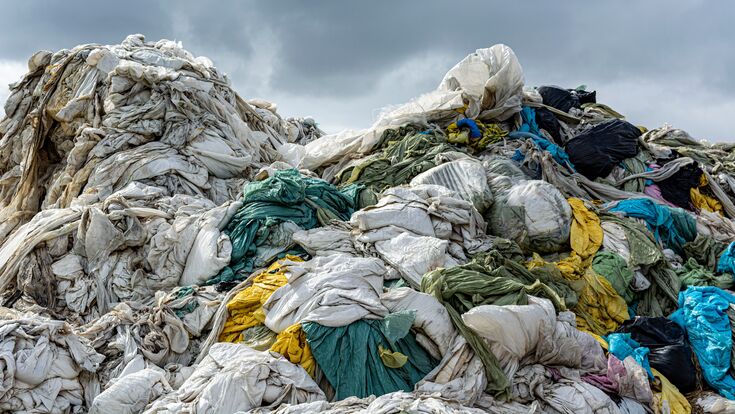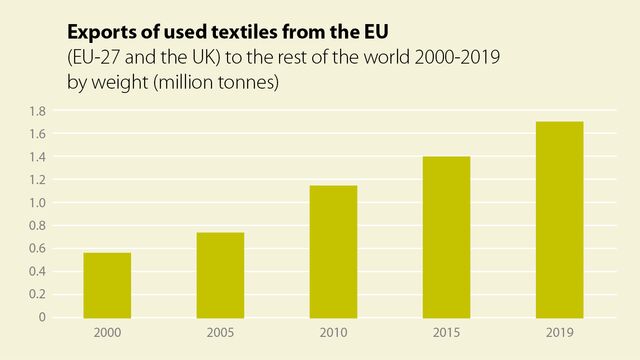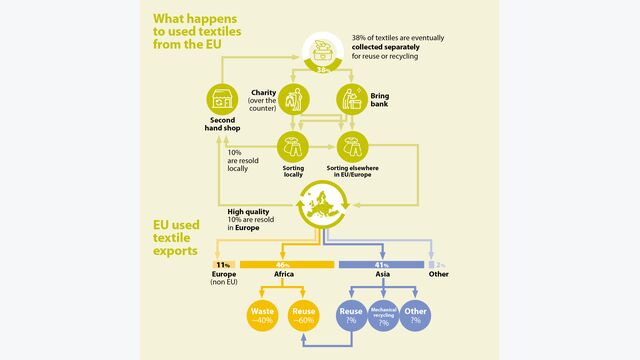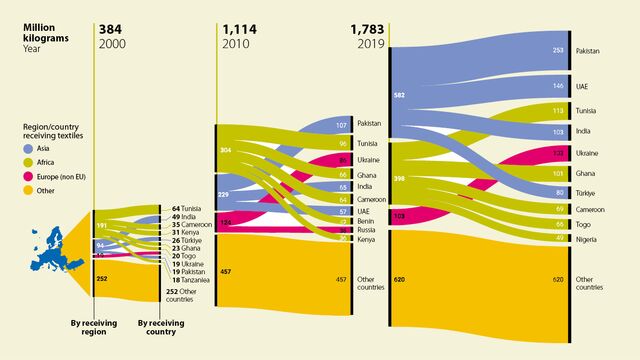Exporting textile waste : Bye bye bye: Europe's problem with used textiles exports

Over the last two decades, there has been an enormous increase in used textiles exports from the EU. Between 2000 and 2019, the amount has almost tripled from 550.000 tonnes to nearly 1.7 million tonnes, a report by the European Environment Agency (EEA) shows (Figure 1). Even more recent data show that in 2020, it has dropped a bit to 1.4 million tonnes, but still, the increase is significant.
At the same time, the value of used textiles has decreased to an average price of EUR 0.57 per kilogram. "In this period, EU consumption of textiles grew a lot, and with that, the number of used textiles. At the same time, there has been demand from other regions to buy our used textiles, which we have challenges handling in Europe," says Lars Fogh Mortensen, Circular economy, consumption, and production expert of the EEA.
No code for textile waste
The codes for used textiles exported from the EU are divided into two principal product codes under the CN product code system: 6309 (worn textiles and clothing) and 6310 (sorted and unsorted used rags and textile waste). Generally, code 6309 should be used for fabrics fit for reuse (second-hand), while code 6310 should be used for textiles not fit for reuse, which may or may not have already been processed, e.g. recycled into other products, such as industrial rags. EU exports have been mainly classified as 6310.
But it's worth noting that many textiles are exported unsorted and most likely contain both items fit and unfit for reuse. So, the classification does not necessarily describe the actual state of what is exported.
Furthermore, there is no specific code for textile waste. While this may seem a technicality, it is a problem because, as Mortensen says: “It becomes impossible to distinguish between used textiles, which can be resold and reused, and used textiles that are waste, which needs to be recycled or incinerated.”
Like our content? Subscribe to our newsletters!

Import-export hubs
It turns out some EU countries, namely Germany, Poland and the Netherlands, are veritable import-export hubs for used textiles. The report only speculates as to the reasons. It could be partly because these countries discard more used textiles, having better collection systems than others, or because they have less domestic reuse. Researchers have found, however, that used textiles are subject to complex trade between EU member states before leaving the region. It is, therefore, likely that the most significant exporters were sending used textiles collected domestically and from other EU countries abroad. Hence, another reason for the concentration of exports in a few EU countries could be that they import used textiles from other EU member states for re-export outside the EU. International shipping ports in some of these countries make them logical export hubs.
Related article: The world's first automatic large-scale textile sorting plant is in Sweden
It becomes impossible to distinguish between used textiles, which can be resold and reused, and used textiles that are waste, which need to be recycled or incinerated.Lars Fogh Mortensen, EEA
Which are the receiving countries?
For the last two decades, Africa has been the leading continent for used textile exports from the EU. But while a couple of years ago, it imported around 60 per cent of the EU exports, Asia has increased its share significantly from 26 per cent in 2000 to 41 per cent in 2019. This is almost equal to Africa, which still imported 46 per cent of EU exports. (Figure 2)
However, the fate of used textiles in the receiving countries is highly uncertain (Figure 3). A fact that does not match the common public perception of used clothing donations as generous gifts to people in need and that the EEA report seeks to rectify: "Until recently, it was not common knowledge that most used textiles were exported out of the EU to Asia and Africa, and that much of that does not end with people in need,” says Mortensen. “We think it was important to analyse and communicate this issue through our briefing ‘EU exports of used textiles in Europe’s circular economy’.”
Related article: EU27 want to ban destruction of unsold clothing
The report shows that African countries import used textiles mainly for local reuse. There is a high demand for cheap used clothing. The part unsuited for reuse ends up in open landfills and the informal waste stream.
But some countries also see those imports as threatening local textile production and have discussed banning used textile imports. "Countries may consider the pros and cons of used textile imports differently,” says Mortensen. “On one hand, the imports can create employment, and the textiles can have value on the market. On the other hand, used textiles can be seen as harmful waste ending in landfills and dumps.”
“It seems likely from the current debate that some countries may restrict the import of used textiles and, in particular, of textiles waste,” he adds. “This is also why it would be important to better separate and distinguish between used textiles that can be resold and textiles waste." The expert foresees more import restrictions in the future: “It seems likely from the current debate that some countries may restrict import of used textiles and in particular of textiles waste. This is also why it would be important to better separate and distinguish between used textiles that can be resold and textiles waste."
The situation in Asia is significantly different from the one in Africa. Here, used textiles are imported to so-called economic zones where they are sorted and processed. Import for local reuse is restricted. It appears instead that used textiles are recycled locally, mainly downcycled into industrial rags or filling, or re-exported either for recycling in other Asian countries or for reuse in Africa. Those textiles that cannot be recycled or re-exported are probably entering the general waste management system, most of which is landfill.
As to why the African and Asian markets are so different, Mortensen says: "At least one reason is that many Asian countries produce a lot of textiles and don't necessarily have a high demand for used textiles or used textiles are not allowed to put on the market. Instead, they may sort textiles, use some for recycling and some are re-exported it seems."
At this point, it is worth noting that as of 2019, Europe is no longer the world's biggest exporter of used textiles. Instead, Asia took the lead. (Figure 4)
Related article: EU wants EPR schemes for textiles
Addressing challenges from textile waste exports
European lawmakers see the need to act. By 2025, all EU countries are obliged to collect textile waste as a separate fraction. It is expected that the amounts used textiles collected will increase further.
The EU strategy on sustainable and circular textiles, published in March 2022, explicitly mentions textile waste exports. There it says:
EU strategy on sustainable and circular textiles addresses textile waste exports
Exports of textile waste outside the EU have been steadily increasing to reach 1.4 million tonnes in 2020. Under the recent Commission proposal for new EU rules on the shipment of waste, the export of textile waste to non-OECD countries would be allowed only under the condition that such countries notify the Commission of their willingness to import specific types of waste and demonstrate their ability to manage it sustainably.
To avoid that waste streams are falsely labelled as second-hand goods when exported from the EU and, in this way, escape the waste regime, based on empowerment foreseen in the proposal, the Commission will consider the development of specific EU-level criteria to make a distinction between waste and certain second-hand textile products. A call under LIFE has been launched to improve the traceability of used textiles and textile waste exports.
The Commission will also work to increase transparency and sustainability in global trade in textile waste and used textiles. At the bilateral level, the EU will be intensifying its cooperation on issues of common interest related to textile waste shipment through its dialogues on the environment with third countries and regions, as well as in the context of the sustainable development chapters of the EU bilateral and region-to-region trade agreements, where relevant, in line with the overall EU objectives to increase the sustainability dimension of its trade policy.
Related article: New study on enzymatic textile recycling
Facing uncertainties
The EEA report lists several uncertainties regarding used textile exports that the EU needs to address sooner rather than later.
- Uncertainty regarding the quality and types of the exported textiles
- Lack of consistent data on quantities and fate of used textiles and textiles waste in Europe. Different countries collect and classify textiles in various ways.
- A better understanding of where the used textiles go after the first receiving country is crucial for identifying what ultimately happens to used textiles exported from the EU.
- “Outsourced reuse” of exported textiles. This also comes with a high degree of uncertainty about the actual level of reuse and recycling.
Unless the used textiles exported from the EU are of a high enough quality to be reused, are not reused for a very long time, or do not replace the purchase of new clothing, they may not really replace new production or benefit the environment. Instead, exports will result in more textiles ending up as waste. The situation may be even worse with limited waste management facilities in many receiving countries. These textiles exported may cause even more environmental damage than if they had been recycled or incinerated in Europe in the first place. According to the EEA report, more research is needed on this.
In other words, the quality of textiles exported from the EU and how this affects their fate is essential.





